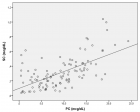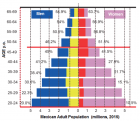Abstract
Research Article
Control of phytopathogenic microorganisms of post-harvest in tomato (Lycopersicon esculentum Mill.) with the use of citrus extract
Rueda Puente Edgar Omar*, Ruíz-Alvarado Cristina, Juan José Reyes-Pérez, Hernández-Montiel Luis Guillermo and Amador Bernardo
Published: 30 March, 2018 | Volume 2 - Issue 1 | Pages: 037-043
Diseases are a major cause of post-harvest losses depending on season, region and management practices. Chemical control is the most used but with serious consequences for human health and the environment. This forces us to carry out more exhaustive studies on botanical products. The general objective of the present study was to evaluate the effect of citrus extracts for the control of pathogens that cause post-harvest diseases in tomato fruit. The product to be evaluated is of botanical origin from citrus extracts. Doses were evaluated (0, 666, 1000, 2000, 4000, 8000 ppm). The treatments were located at a temperature of 25°C±2 and 45% relative humidity (rH). The design used corresponded to a completely random design. The least significant difference was estimated by Tukey Multiple Range test at P=0.05. The statistical tests were performed through the SAS computer program. The results indicate that the pathogens detected and identified correspond to Alternaria tenuissima; Botrytis cinerea; Cladosporium fulvum; Colletotrichum coccodes; Fusarium oxysporum; Geotrichum candidum; Rhizopus stolonifer and Stemphylium macrosporoideum. Our conclusion is that the efficient doses correspond to 666, 2000 and 8000 ppm. With the application of citrus extracts, the damage percentage of tomato fruit was reduced in relation to the control treatments. Based on the results with the application of citrus extracts, the shelf life of the tomato was lengthened.
Read Full Article HTML DOI: 10.29328/journal.jpsp.1001018 Cite this Article Read Full Article PDF
Keywords:
Botanic; Extracts; Control; Diseases; Post-harvest; Tomato
References
- Jaramillo N, Rodríguez V, Guzmán A, y Zapata Miguel A. El cultivo de tomate bajo invernadero (Lycopersicon esculentum. Mill). C O R P O I C A Centro de Investigación La Selva Rionegro, Antioquia, Colombia. 2006; 320.
- Spadaro D, Droby S. Development of biocontrol products for post-harvest diseases of fruit: The importance of elucidating the mechanisms of action of yeast antagonists. Trends in Food Science and Technology. 2016; 47: 39-49. Ref.: https://goo.gl/9zSJjp
- Wang Y, Tang F, Xia J, Yu T. A combination of marine yeast and food additive enhances preventive effects on post-harvest decay of jujubes (Zizyphus jujuba). Food Chemistry. 2011; 125, 835-840. Ref.: https://goo.gl/s6wf5W
- Droby S, Wisniewski M, Macarisin D, Wilson C. Twenty years of post-harvest biocontrol research: Is it time for a new paradigm? Post-harvest Biology and Technology. 2009; 52: 137-145. Ref.: https://goo.gl/79SwTk
- Burt S. Essential oils: their antibacterial properties and potential applications in foods-a review. International Journal of Food Microbiology. 2004; 94: 223-253. Ref.: https://goo.gl/t45RhP
- Parafati L, Vitale A, Restuccia C, Cirvilleri G. Biocontrol ability and action mechanism of food-isolated yeast strains against Botrytis cinerea causing post-harvest bunch rot of table grape. Food Microbiology. 2015; 47: 85-92. Ref.: https://goo.gl/WeuBV4
- Romanazzi G, Smilanick JL, Feliziani E, Droby S. Integrated management of postharvest gray mold on fruit crops. Postharvest Biology and Technology. 2016; 113: 69-76. Ref.: https://goo.gl/5Xpw3D
- Krishnapillai N, Wijeratnam RSW. Sap volatile components in relation to susceptibility of anthracnose and Aspergillus rot of mangoes (Mangifera indica L.). The Journal of Horticultural Science and Biotechnology. 2017; 92: 206-213. Ref.: https://goo.gl/Y3MsMj
- Gilman JC. A Manual of Soil Fungi. Compañía Editorial Continental. México. 1963; 873.
- Romero C. Hongos Fitopatógenos. Universidad Autónoma Chapingo. México. 1993; 347.
- Barnett HL, Hunter BB. Ilustrated Genera of Imperfect Fungi.4 ed. APS (Tha American Phytopathology Society). USA. 1998; 258. Ref.: https://goo.gl/ZkdhqL
- Abad G. Revisión del Genero Fusarium. Primer Taller Internacional sobre “Identificación de Hongos y Stramenopilas Transmitidos por Semillas” North Carolina State University. México. 2002; 339.
- Salazar V. Evaluación de cera orgánica aplicada sobre frutos de litchi (Litchi chinensis sonn) en manejo postcosecha. UAAAN, Buenavista, Saltillo Coah. Mexico. 2012; 55.
- Ultee A. Acción bactericida del carvacrol hacia el patógeno del alimento, el bacilo de cirio, (on line). 2002.
- León GHM, y Arosemena DM. El cultivo del tomate en el Valle de Culiacán Para Consumo Fresco. SARH. Culiacán, Sinaloa, México. 2010; 274.
- Zhu X, Cao J, Wang Q, Jiang W. Postharvest infiltration of BTH reduces infection of mango fruits (Mangifera indica L. cv. Tainong) by Colletotrichum gloeosporioides and enhances resistance inducing compounds. Journal of Phytopathology. 2008; 156, 68-74. Ref.: https://goo.gl/1zMe4x
- de Lima JR, Gonçalves LR, Brandão RL, Rosa CA. Isolation, identification, and activity in vitro of killer yeasts against Colletotrichum gloeosporioides isolated from tropical fruits. Journal of Basic Microbiology. 2013; 53; 590-599. Ref.: https://goo.gl/3gTqNn
- Walton NJ, Brown DE. Chemical from plants. Perspectives on plants secondary products. Imperial College Press. 1999; 273.
- Vaillancourt L. Research in Plant Pathology and Fungal Genetics. University of Kentuchy. Mycol Res. 2009; 106: 653-662.
- Valencia BRC. Evaluación de extractos de cítricos contra patógenos de postcosecha en el cultivo del tomate (Licopersicon esculentum Mill. Var. Saladette). Universidad Autónoma Agraria Antonio Narro. Buenavista, Saltillo Coah. 2002; 73.
- Casas A, Siura S. y Ugas R. Tomate. SAMCONET. 2002; 435.
- Oliveira R. Etiología y control químico de la Aceituna Jabonosa causada por Colletotrichum spp. Tesis doctoral, ETSIAM, Universidad de Córdoba. 2003; 260.
- Oussalah MJ. Food Prot. 2006; 69: 1046-1055.
- Victorino JA. Efecto de tres ambientes en calidad postcosecha de genotipos de tomate (Solanum lycopersicum L.) Con pedúnculo, extra firme y de larga vida de anaquel. UAAAN, Buenavista, Saltillo Coah. Mexico. 2013; 55.
- Yli-Mattila T. Molecular, morphological and phylogenetic analysis of the F. avenaceum/F. arthrosporoides/F. tricinctum species complex-a polyphasic approach. Mycol Res. 2002; 106: 655-669. Ref.: https://goo.gl/QerPwE
Figures:

Figure 1

Figure 2
Similar Articles
-
Phytochemical content of leaf and stem of Marsilea quadrifolia (L.)Rajangam Udayakumar*,Karikalan Gopalakrishnan. Phytochemical content of leaf and stem of Marsilea quadrifolia (L.). . 2017 doi: 10.29328/journal.jpsp.1001003; 1: 026-037
-
Antagonistic features displayed by Plant Growth Promoting Rhizobacteria (PGPR): A ReviewMohsin Tariq*,Muhammad Noman,Temoor Ahmed,Amir Hameed,Natasha Manzoor,Marriam Zafar. Antagonistic features displayed by Plant Growth Promoting Rhizobacteria (PGPR): A Review . . 2017 doi: 10.29328/journal.jpsp.1001004; 1: 038-043
-
HBV: Genomic Structure, HBVsAg Isolation and innovative Virotherapy Initiation in the Middle EastAboul-Ata E Aboul-Ata*,Essam M Janahi,I M El-Kalamawy,Kathleen Hefferon,Amal Mahmoud. HBV: Genomic Structure, HBVsAg Isolation and innovative Virotherapy Initiation in the Middle East . . 2017 doi: 10.29328/journal.jpsp.1001007; 1: 059-061
-
Common transcriptional regulation of ABA and ethyleneRavi Valluru*. Common transcriptional regulation of ABA and ethylene. . 2018 doi: 10.29328/journal.jpsp.1001013; 2: 001-005
-
Pharmacological effects of Nephrolepis exaltata L. (fern) aqueous extract on an insect-based model (Nauphoeta cinerea)Sandro Rostelato-Ferreira*,Danrley Mariel Egidio Sanchez,Jocimar de Souza,Yoko Oshima-Franco. Pharmacological effects of Nephrolepis exaltata L. (fern) aqueous extract on an insect-based model (Nauphoeta cinerea). . 2018 doi: 10.29328/journal.jpsp.1001017; 2: 031-036
-
Control of phytopathogenic microorganisms of post-harvest in tomato (Lycopersicon esculentum Mill.) with the use of citrus extractRueda Puente Edgar Omar*,Ruíz-Alvarado Cristina,Juan José Reyes-Pérez,Hernández-Montiel Luis Guillermo,Amador Bernardo. Control of phytopathogenic microorganisms of post-harvest in tomato (Lycopersicon esculentum Mill.) with the use of citrus extract. . 2018 doi: 10.29328/journal.jpsp.1001018; 2: 037-043
-
Detection of Clavibacter michiganensis subsp. michiganensis in tomato and chili seeds and farming area of Sinaloa, MexicoRuiz Alvarado Cristina*,Soto Ortiz Roberto,Cervantes Diaz Lourdes,Nuñez Ramirez Fidel,Celaya-Michel Hernán,Rueda Puente Edgar O. Detection of Clavibacter michiganensis subsp. michiganensis in tomato and chili seeds and farming area of Sinaloa, Mexico. . 2018 doi: 10.29328/journal.jpsp.1001019; 2: 044-054
-
Life history strategies of the armored scale, Aulacaspis alisiana (Hemiptera: Coccoidea: Diaspididae) on the Japanese silver tree Neolitsea sericea (Bl.) Koidz. (Lauraceae) in Fukuoka, JapanCharles AO Midega*,Keiji Takasu. Life history strategies of the armored scale, Aulacaspis alisiana (Hemiptera: Coccoidea: Diaspididae) on the Japanese silver tree Neolitsea sericea (Bl.) Koidz. (Lauraceae) in Fukuoka, Japan. . 2018 doi: 10.29328/journal.jpsp.1001020; 2: 055-058
-
Bacillus amyloliquefaciens as a plant growth promoting bacteria with the interaction with of grass salt Distichlis palmeri (Vasey) under field conditions, in desert of Sonora, MexicoRueda Puente Edgar O*,Ruiz Alvarado Cristina,Jesús Borboa Flores,Victor Cardenas Salazar,Soto Ortiz Roberto,Lourdes Díaz Cervantes. Bacillus amyloliquefaciens as a plant growth promoting bacteria with the interaction with of grass salt Distichlis palmeri (Vasey) under field conditions, in desert of Sonora, Mexico. . 2018 doi: 10.29328/journal.jpsp.1001021; 2: 059-067
-
Stability determination of candidate reference genes in cucumber plants subjected to stresses from Phytophthora melonisTingquan Wu*,Rui Wang,Hu Du,Qingmin Jin,Yujuan Zhong,,Chunpeng Yao,Xiaomei Xu,Yu’e Lin. Stability determination of candidate reference genes in cucumber plants subjected to stresses from Phytophthora melonis. . 2019 doi: 10.29328/journal.jpsp.1001028; 3: 028-035
Recently Viewed
-
Sinonasal Myxoma Extending into the Orbit in a 4-Year Old: A Case PresentationJulian A Purrinos*, Ramzi Younis. Sinonasal Myxoma Extending into the Orbit in a 4-Year Old: A Case Presentation. Arch Case Rep. 2024: doi: 10.29328/journal.acr.1001099; 8: 075-077
-
Improvement of the Cognitive Abilities in a Chronic Generalized Anxiety Disorder and Moderate Depression Case using a Novel Integrated Approach: The Cognitome ProgramMohita Shrivastava*. Improvement of the Cognitive Abilities in a Chronic Generalized Anxiety Disorder and Moderate Depression Case using a Novel Integrated Approach: The Cognitome Program. J Neurosci Neurol Disord. 2024: doi: 10.29328/journal.jnnd.1001100; 8: 069-089
-
Neuroprotective Effect of 7,8-dihydroxyflavone in a Mouse Model of HIV-Associated Neurocognitive Disorder (HAND)Tapas K Makar, Joseph Bryant, Bosung Shim, Kaspar Keledjian, Harry Davis, Manik Ghosh, Ajay Koirala, Ishani Ghosh, Shreya Makar, Alonso Heredia, Malcolm Lane, J Marc Simard, Robert C Gallo, Volodymyr Gerzanich*, Istvan Merchenthaler*. Neuroprotective Effect of 7,8-dihydroxyflavone in a Mouse Model of HIV-Associated Neurocognitive Disorder (HAND). J Neurosci Neurol Disord. 2024: doi: 10.29328/journal.jnnd.1001101; 8: 090-105
-
Adult Neurogenesis: A Review of Current Perspectives and Implications for Neuroscience ResearchAlex, Gideon S*,Olanrewaju Oluwaseun Oke,Joy Wilberforce Ekokojde,Tolulope Judah Gbayisomore,Martina C. Anene-Ogbe,Farounbi Glory,Joshua Ayodele Yusuf. Adult Neurogenesis: A Review of Current Perspectives and Implications for Neuroscience Research. J Neurosci Neurol Disord. 2024: doi: 10.29328/journal.jnnd.1001102; 8: 106-114
-
Analysis of Psychological and Physiological Responses to Snoezelen Multisensory StimulationLucia Ludvigh Cintulova,Jerzy Rottermund,Zuzana Budayova. Analysis of Psychological and Physiological Responses to Snoezelen Multisensory Stimulation. J Neurosci Neurol Disord. 2024: doi: 10.29328/journal.jnnd.1001103; 8: 115-125
Most Viewed
-
Evaluation of Biostimulants Based on Recovered Protein Hydrolysates from Animal By-products as Plant Growth EnhancersH Pérez-Aguilar*, M Lacruz-Asaro, F Arán-Ais. Evaluation of Biostimulants Based on Recovered Protein Hydrolysates from Animal By-products as Plant Growth Enhancers. J Plant Sci Phytopathol. 2023 doi: 10.29328/journal.jpsp.1001104; 7: 042-047
-
Sinonasal Myxoma Extending into the Orbit in a 4-Year Old: A Case PresentationJulian A Purrinos*, Ramzi Younis. Sinonasal Myxoma Extending into the Orbit in a 4-Year Old: A Case Presentation. Arch Case Rep. 2024 doi: 10.29328/journal.acr.1001099; 8: 075-077
-
Feasibility study of magnetic sensing for detecting single-neuron action potentialsDenis Tonini,Kai Wu,Renata Saha,Jian-Ping Wang*. Feasibility study of magnetic sensing for detecting single-neuron action potentials. Ann Biomed Sci Eng. 2022 doi: 10.29328/journal.abse.1001018; 6: 019-029
-
Pediatric Dysgerminoma: Unveiling a Rare Ovarian TumorFaten Limaiem*, Khalil Saffar, Ahmed Halouani. Pediatric Dysgerminoma: Unveiling a Rare Ovarian Tumor. Arch Case Rep. 2024 doi: 10.29328/journal.acr.1001087; 8: 010-013
-
Physical activity can change the physiological and psychological circumstances during COVID-19 pandemic: A narrative reviewKhashayar Maroufi*. Physical activity can change the physiological and psychological circumstances during COVID-19 pandemic: A narrative review. J Sports Med Ther. 2021 doi: 10.29328/journal.jsmt.1001051; 6: 001-007

HSPI: We're glad you're here. Please click "create a new Query" if you are a new visitor to our website and need further information from us.
If you are already a member of our network and need to keep track of any developments regarding a question you have already submitted, click "take me to my Query."

















































































































































